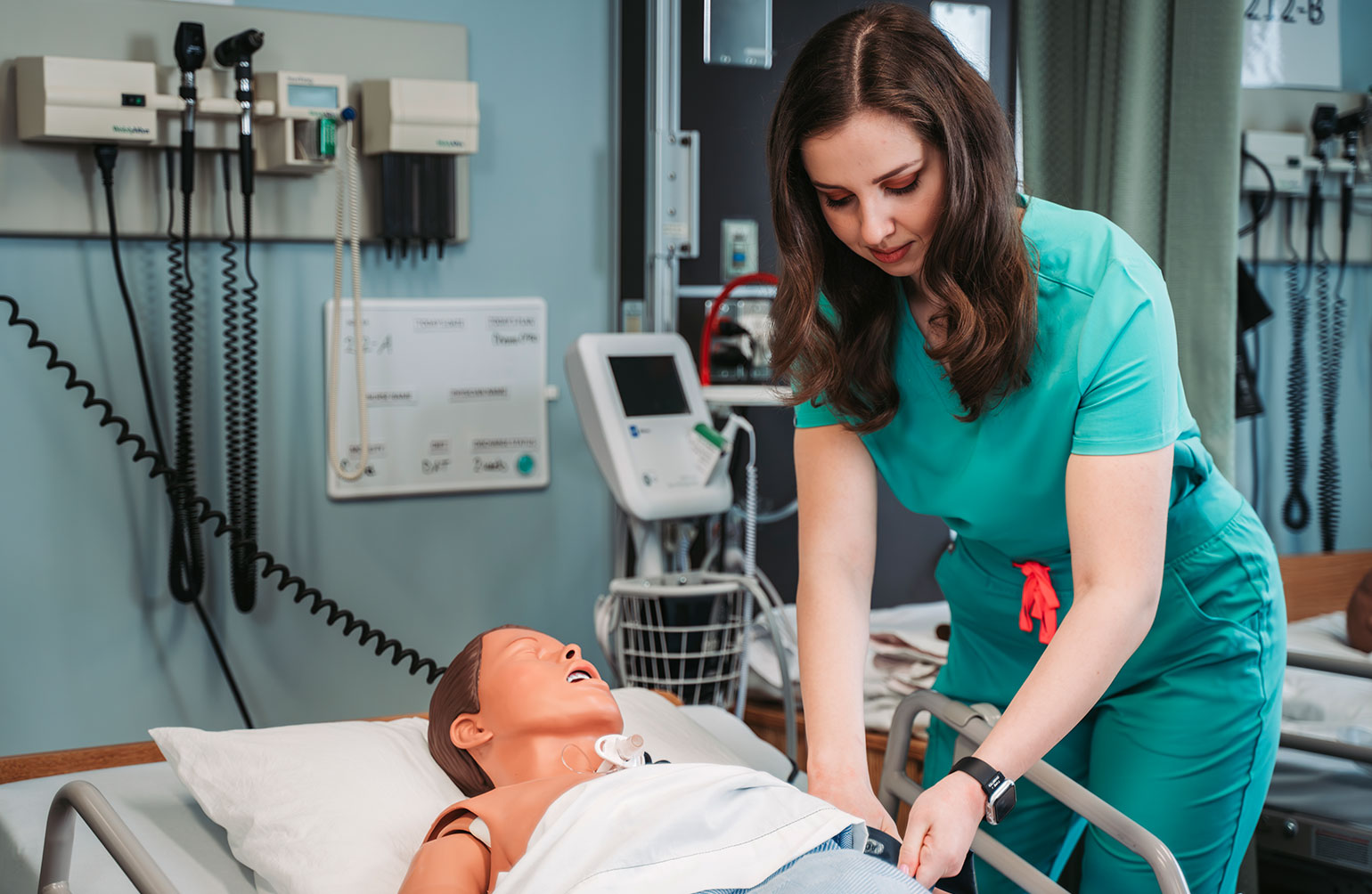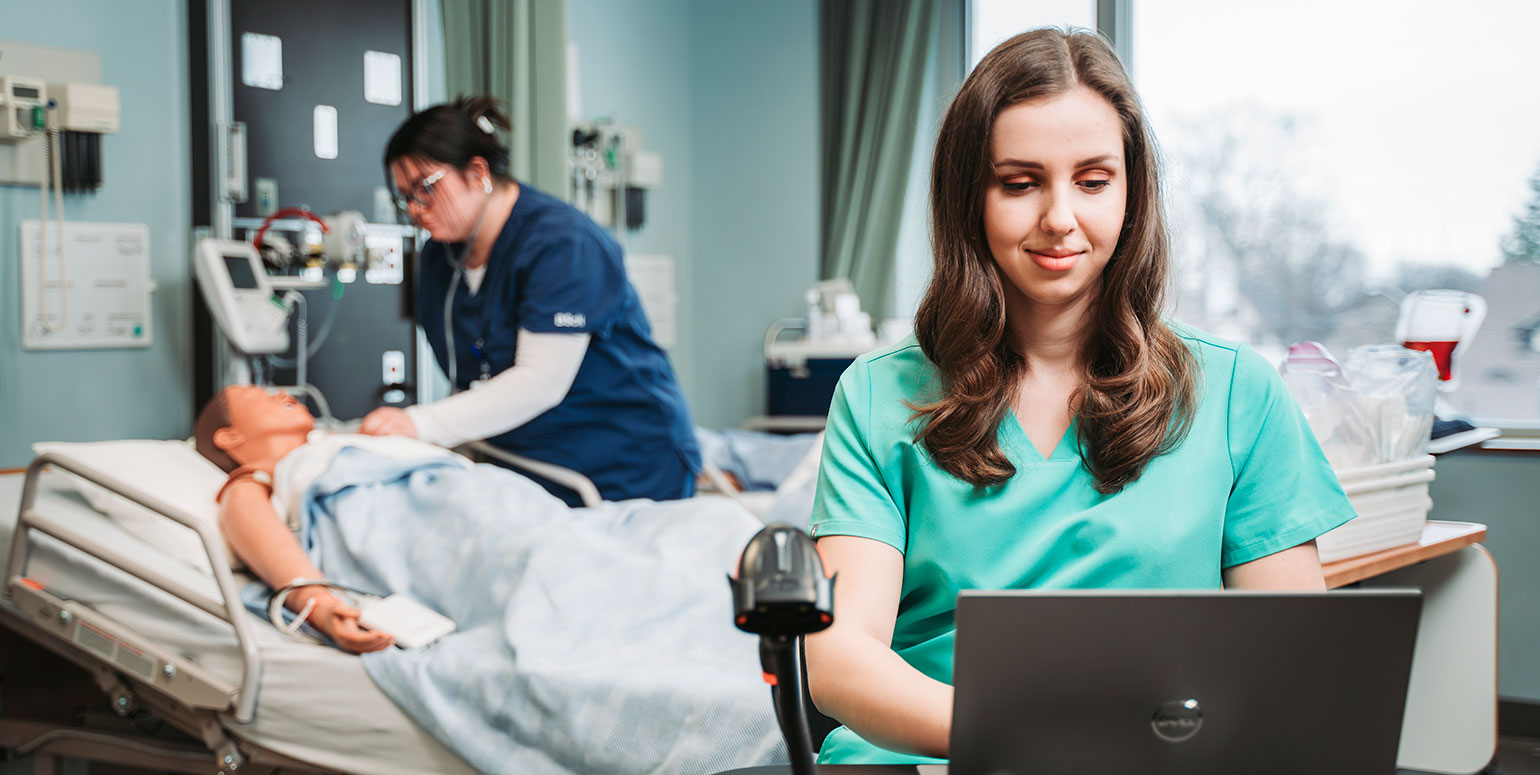
Sylwia Borawski works with a medical mannequin in the simulation lab of the Health Education Centre.
Sylwia Borawski knows what it feels like to be a patient.
At age 13, she received a life-altering diagnosis — Type 1 diabetes.
Among the chaos of the bustling emergency room where she would spend days clouded with confusion as she learned the details of her new diagnosis, one moment of compassionate care stands out to Borawski, helping to shape her own future as a caregiver.
“On the night of my diagnosis, an ER nurse took the time to sit with me and my family. Despite the commotion of the busy emergency room, she patiently walked us through everything,” Borawski recalled.
“I remember she used a surgical marker to draw diagrams on the bed sheet, illustrating how my sugar levels would fluctuate and why insulin was necessary.
“You don’t expect someone to take that time — but she did.”
From patient to caregiver
Now working as an emergency room nurse at Henry Ford Hospital in Dearborn, Mich. after graduating from the University of Windsor’s Faculty of Nursing in 2023, Borawski said that experience opened her eyes to the key role of nurses, and how vital they are to a patient’s experience during frightening, or uncertain times.
“I try to create those little moments among the chaos in my own ER,” she said. “I think it’s come full circle that way. It really makes you appreciate what patients are going through.”
Her personal experience, coupled with an early interest in science, drove her journey toward a career in nursing. As a first-generation student who was born and raised in Windsor, it was important to her to stay close to home.
Borawski visited the University of Windsor with her family and liked what she saw on campus. She was excited about the program, particularly its smaller clinical groups and first-year involvement in a hospital setting.
“When we go into a clinical setting there’s eight students to one instructor,” she explained. “And at a lot of institutions that’s not the case. So having that more individualized experience was extremely helpful.”
Experience that Borawski credits as key to getting comfortable in a busy, patient-focused environment.
“Looking back, I didn’t know exactly what I would need from my learning,” she reflected.
“But I’ve come to realize the most crucial piece for me was that clinical time. There is only so much theory that you can stomach before you are looking for that hands-on experience to apply what you have learned.”
Lessons learned in research and practice
During her undergraduate studies, Borawski dove headfirst into research and applied for the University’s Outstanding Scholars program, which offers students paid opportunities outside the classroom to work for faculty members on their research.
“I feel that working in research was such a unique experience, and it helped me to gain a deeper understanding of just how important evidence-based practice is,” she said. “Contributing to evidence that can then be applied to practice was essential to my journey as an undergraduate student.”
Exploring a variety of subjects, Borawski contributed to five peer-reviewed publications alongside an all-female research team investigating nurse practitioner opioid prescribing and safety measure utilization in Ontario.
This involved a mixed-method study, and when she joined, the team was analyzing survey results and moving into qualitative interviews, granting Borawski the opportunity to engage with nurse practitioners across the province.
“We had some interesting insights as to why certain safety measures are used, why certain opioids were utilized more often, what nurse practitioners feel still needs improvements, in terms of enforcing safety measures, what they felt was effective versus ineffective,” she explained.
From there, Borawski branched out to work on her own publication. Like many, her learning experience was affected by the COVID-19 pandemic. She decided to use her voice to speak to the experience of student nurses during those uncertain times.
In 2020, when much of the world was under lockdown and hospitals were overburdened by outbreaks, the first roll-out of vaccines had limited supply and was offered only to essential workers, including nursing staff — leaving out student supporters, despite their involvement in clinicals each week and their close work with patients completing regular assessments and administering medications.
“I wrote a commentary for Canadian Nurse discussing that experience,” she said. “Then, I transitioned back to researching nurse practitioner practice and patient presentation in Ontario, particularly considering the changes brought on by COVID-19. Interviews with nurses and nurse practitioners across the province told us about significant challenges, including delays in care, patients’ reluctance to seek medical attention, and instances of more advanced disease presentations.”
Borawski said this experience opened her eyes to the many opportunities she could explore with her nursing degree, and the vital role research plays in patient care.
“High-quality evidence such as randomized control trials or systematic reviews will give us information about what we should be doing and about what promotes the best positive patient outcomes and what promotes any negative outcome,” she said. “You need that evidence to guide you in your everyday practice.”

Facilities in the Faculty of Nursing enable students to gain understanding of clinical settings.
Embracing leadership and community engagement
After graduating from the program with a wealth of experience under her belt, Borawski still wasn’t finished with her learning journey. She decided to continue her studies and work toward her master’s degree, this time with more of a practical, clinical focus.
“In my final year, I took on the role of a peer mentor in the lab, which was a fantastic experience. I loved guiding fellow students, and this experience inspired me to pursue a master’s degree to hopefully secure a teaching or leadership position down the line,” she said.
Borawski is now involved in the Graduate Nursing Society, where she takes part in local events in an effort to give back to the community, and works as a mentor for undergraduate students, in addition to her job at the hospital.
“I believe it’s important not only to focus on professional development and theoretical learning, but also to recognize the value of engaging with and becoming an active member of your community, contributing in a positive way to improve the lives of others,” she said.
Borawski’s face lights up when she talks about that contribution, and her work in the ER. Among the day-to-day commotion, and through some tougher moments, she said her connections with patients and their families help her recognize the meaningful difference she makes each day.
“We’ve had a few scares with some very young kids lately with cold and flu season, and when they first come in due to some trouble breathing, they may be in a code situation or the resuscitation area and hearing from parents when they see their child is slowly getting better is really impactful.
“I have had patients tell me at the end of it, ‘I’ve never had a nurse take care of me the way you have.’”
The pandemic placed a spotlight on the significant part nurses play in our health-care system, with “health-care hero” signs and community members banging pots and pans on their porches to show their appreciation to the essential workers — a recognition Borawski feels was long overdue.
“When you’re a nurse you never really clock out,” she said. “I will have neighbours, family members, and friends reaching out to me and asking me questions about their health, or opinions based on what their doctor said. So even outside the hospital, there is such a broad scope of what we do in the community.”
Nurses are often the closest person to the patient when it comes to discussions about their health, Borawski said. With regular communication and check-ins, patients often feel more comfortable asking questions when a nurse is around.
“I think the best way I can describe it is we’re just that constant presence for patients, someone who cares.”
